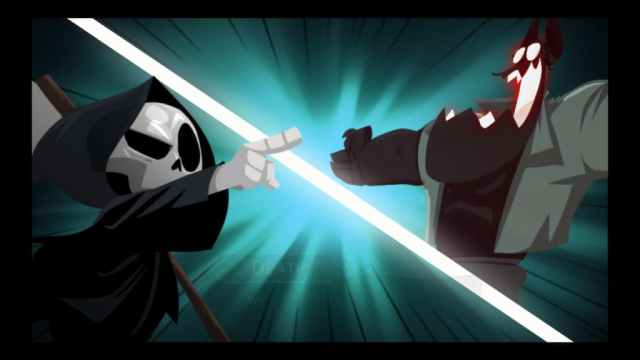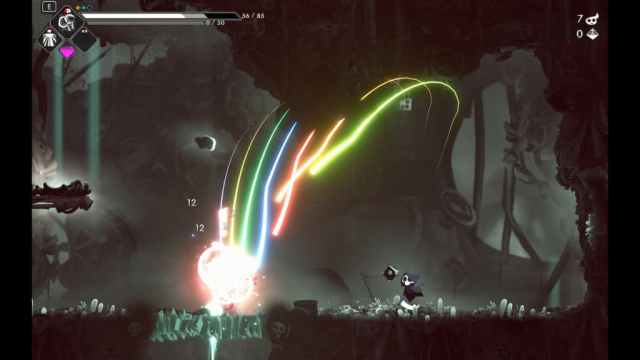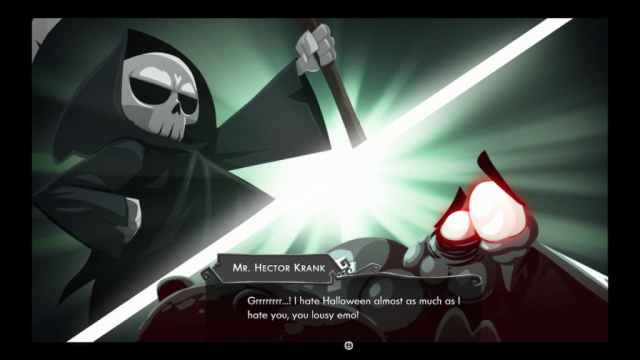Have a Nice Death Review | Dying is Literally the Easy Part
Welcome to the afterlife!

Being chained down to a toxic work environment will eventually result in a lot of pent-up anger for any poor suffering employee, and sometimes all they want is to pour it all out in the most reasonable way.
Now, replace that poor employee for the CEO of one of the most successful companies in the world’s history, and it just happens that he’s also one of the most powerful and ancient entities to ever walk upon this mortal realm. For he and he alone dictates our remaining time on the Earth. Give it some cartoony elements, and you’ve got the premise for Have a Nice Death.
The game has been around for almost a year in Early Access, and I decided to give it a chance for a few hours last year. Fast forward to 2023 and I’m back to Death Inc. to see how much it has improved over time for its full release. Time to find out.
Have a Nice Death | You’re Not Safe from Capitalism in Death (And Neither is Death Himself)
This charming 2D sidescroller roguelike has a simple story. Once upon a time, there was Death, who canonically goes with masculine pronouns in this game. Death use to travel all around the world determined to unlive every living being who had been around past their time. But he didn’t expect the job to get so complicated, so he created a fate worse than himself: post-life employment.
He sought the help of the Sorrows, who would be responsible for all of the reaping with their trustful minions (damned souls who have to work in the afterlife!) Death would act as the head of Death Inc., your average successful bureaucratic company with its fair share of dreadful departments. Each department deals with different types of deaths, each of them led by a Sorrow.
But the Sorrows would eventually plot to overthrow Death of his position. They started slacking off and would toss all of their paperwork for the CEO to handle. Now it’s up to him to show the Sorrows who’s the real boss around.
You take the mantle of this burned-out company founder in a fast-paced game in which your final objective is to take a break at the beach. But before that, you gotta make sure that everyone’s doing their job. People will never stop dying, so you gotta make sure they’re at least dying correctly.
A New Suit For Each Meeting
The intro cutscene has Death dissing out his previous businessman suit and bringing back his trademark Cloak alongside his equally iconic Scythe. With those tools at his disposal, he starts his rampage seeking to end his eternal burnout.
Each run has you “visiting” the departments, “speaking” with the lower employees, and eventually having a “meeting” with the responsible Sorrow. From the big-sized, small-brained gargoyle Brad to the explosive and maniac Major Warren Pliskhan, they’ll always await you on the last floor of the department, ready to send you back to your desk if you’re not deadly enough.
Departments are themed around common death causes such as toxic environments, natural disasters, wars, and even malefic fast foods. You’ll find plenty of lesser enemies before the Sorrows, and might even stumble across one of the Thanagers, mini-bosses who are often stronger than the big heads themselves.
If you ever played any other roguelike games such as Dead Cell or Hades, you know how the game loop goes. New run begins > you go as far as you can > you die > hang around in your office for a bit > new run begins. It gets even more ironic since you’re literally Death.

Due to his diminutive size, Death is no longer as powerful as in the ancient legends. So he has to rely on the Curses given by Mr. O’Shah, one of his loyal employees, to get through the chaotic departments.
Curses are divided into three categories that grant different bonuses from the generic extra damage ones to some special effects such as inflicting poison when hitting a target. You can get them randomly while traversing through the building and slowly makes your own deadly build to deal with your collaborators.
Death carries his magical Codex to unleash spells, and both his Cloak and Scythe can take new forms to slash through those helpless employees. The various random options between Curses, Spells, Weapons and Scythes make sure that each run feels unique regardless of following the same path every time.
Repetition is always around, but is never a hindrance. Use it to your advantage instead to do better next time. Eventually you learn to embrace repetition just like we’ll all embrace death one day. And that means learning how to make the best out of a given chance.
Defeating enemies gives you Soulary which can be spent on many different items such as heals, Curses or upgrades at certain special rooms. That is, if you’re lucky enough to find them.
“Eventually you learn to embrace repetition just like we’ll all embrace death one day. And that means learning how to make the best out of a given chance.“
Related: Dead Cells: Return to Castlevania Review | Belmont Buds
Randomly-Generated-Frustrations
RNG is a natural element in roguelikes and one of the biggest reasons they’re such thrilling experiences. You never know what you’ll get, so you gotta make whatever’s handed to you work. There’s usually a certain degree of control/prediction, but every run is ultimately a new, random experience every time.
This is a good thing in most roguelikes, but Have a Nice Death struggles a bit because of it. Some Spells and Weapons are so much stronger than others that you can easily stagger most enemies with them and then head for the kill. Did I mention that you can also stagger bosses? Combine it with special Curses that give you extra damage for stunned enemies and suddenly everything becomes a walk in the park.
In contrast, some pieces of equipment don’t feel as powerful even after upgraded, and the clear time (or eventual run failure) will show how worse they actually are compared to others despite sharing the same rarity. It’s more than a certified “git gud” moment. This problem becomes more blatant with higher Breakdown (difficulty) levels, where enemies get more defense and multi-hitting weapons become less efficient. I went up to Breakdown III, but it felt like I didn’t deserve to be there just yet as I could only do it with certain types of weapons.

Room RNG isn’t the best either. You might go through a whole run without being given the chance to visit a Shop or a Control Room more than once, making your Soulary basically useless. Consequently, you might arrive at the Sorrow in a weaker state than expected.
You lose everything when you die, but in each run, you get Experience that unlocks some perks such as Elevators that go straight to a Sorrow’s office, new weapons or starting the game with extra heals. But there’s nothing that immediately gives you more raw power.
You also keep any Gold Ingots you found, but they unlock mainly spells and weapons which you also need to find before you can use them. To be fair, you can always start your next run with something you just bought from Joe’s shop, but that only happens once per item.
This all combines for a dreadful early game experience. Luckily there’s an “Easy Mode” you can toggle in Death Inc.’s main lobby, but eventually you’ll grow tired of it. And after you try a higher difficulty, the game will brutally kick you in the face until you pass out and tell you that you’re not allowed in the grown-ups club yet.
Again, this is not uncommon with roguelikes. But the game somehow lacks that grip that makes you want to go back and get all beaten up again. There are many compelling themes and characters to enjoy, but these problems can make them get old faster than you can die in the Modern Warfare Department.
Death’s Not The Worst, But Not The Best Either
The game still manages to deliver a lot of enjoyment though, and that’s what matters at the end of the day. The art style is somber and dark, but it’s still very expressive and reminiscent of old cartoons. Combine it with the excellent soundtrack and you have a perfect setting for a satire of modern business companies that makes their employees work to their deaths (or even after it, like it happens here).
Soundtrack is actually essential for gameplay as it’s one of the main methods you have to know that you’re in danger. Music stops and you hear a broken record sound whenever you receive a hit. This is especially helpful in rooms infested with enemies, where it becomes hard to notice you’re taking hits if you’re playing with no sound.
Characters are vivid and it’s fun to see those little interactions between the associates during each run or after you go back to your office. My favorites are definitely the oblivious-but-precious intern Pump Quinn and the very first Sorrow, Brad, who sometimes talks in hashtags like a real boomer. He’s the only boss with a “serious mode” alternative battle too, which is neat.
The environment feels alive and ever-changing, and they actually do a good job with the corporation setting. Using certain office decorations will also trigger questlines such as the Halloween ritual, while other quests trigger automatically such as the arrangements for The Little Mermaid play (Krank, the crab Sorrow, is asked to play Sebastian. It’s wonderful).

Each new boss offers a difficult but fair challenge, and Thanagers are nice side objectives if you feel like challenging yourself a bit further. There are also the untraditional floors where you need to clear it without being hit, reach the other side quickly or defeat all enemies before time runs out.
Related: Labyrinth of Galleria: The Moon Society Review | Trauma, Puppet Armies, and the Power of Friendship
There’s a lot to delve into this game, but I feel that it lacks something unique. Between its corny (but sometimes excessively cringe) dialogue, fast-paced gameplay, and amazing art direction, it ultimately falls into the “Great, but nothing special” category for me. As mentioned before, I felt no “big grip” from it, and this is a game based around a repetitive gaming loop. Some runs just felt unrewarding even after succeeding, so I would put the game down and play something else instead.
The game is still interesting and I’m definitely willing to give it another chance sooner or later. I had very fun and nice deaths, and I’m sure there are a lot more lives worth losing here later.
Pros:
- Charismatic art style with an excellent satirical humor
- Tons of unlockable weapons and spells
- Difficulties for both casual and veteran players
Cons:
- Balance issues with a few Curses/weapons
- Game often feels unrewarding
- RNG can screw you more than it should
Score: 7.5
A copy of this game was provided by the publisher for review. Reviewed on PC.
